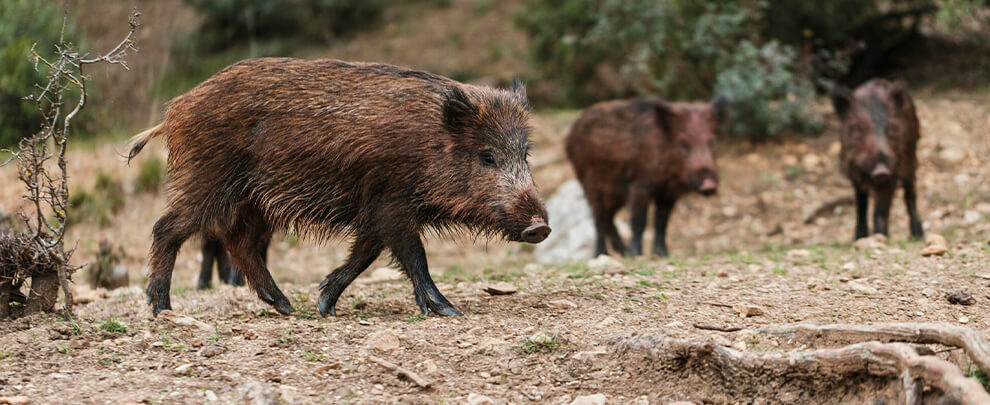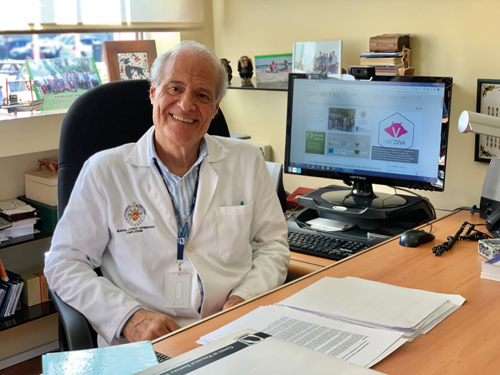Blog
Blog

How is the development of the ASF vaccine progressing?
19th December 2023 - News
After a long professional career focused on battling African Swine Fever (ASF), José Manuel Sánchez-Vizcaíno is currently leading the EU VACDIVA project, which aims to develop a safe, effective and DIVA (Differentiating Infected from Vaccinated Animals) vaccine against this virus. After different trials with excellent results in the laboratory, Sánchez-Vizcaíno and his team are now evaluating and analysing the other possibilities to test the vaccine in a controlled, natural habitat. In this interview, he explains the latest advances in vaccine development and the steps that remain before it is commercialised.

José Manuel Sánchez-Vizcaíno in his office. Photo: J. M. Sánchez-Vizcaíno.
When are you to start working on the ASF vaccine?
I started working with ASF with my doctoral thesis in 1977. So, I was working with Professor Sánchez Botija, who was the one who knew the most about ASF at the time and from whom I learned a lot. He had already tested a vaccine in the 1960s, as did Manso Ribeiro in Portugal, although what was most worrying at that time was controlling the disease, and that is why I focused mainly on its diagnosis and on the development of the ELISA (enzyme-linked immunosorbent assay) which, for the first time, was used for a viral illness. After that, I spent some time away from research, working on the control and eradication of ASF in different epidemiological scenarios and researching possible strategies to improve its management, including a potential vaccine. Along those lines, we started working on the VACDIVA project four years ago, which we presented to the EU for funding. This project aims to find an ASF vaccine and involves a consortium of specialists from different areas. Since we started working, and thanks to advances in molecular biology, we have made a lot of progress and have identified genes linked to the immune response to this complicated virus.
What progress have you made in the last year in developing the vaccine?
In this last period, we have made more progress in choosing positive mutants that render good protection, that is, in determining which ones are better to achieve a safe and effective defence against the virus. We have done many trials with different mutants, both in wild boar and in domestic pigs. These tests, which have lasted up to 40-50 days in wild boars, have been carried out at laboratory level, with the limitations that this entails, and with relatively small groups of animals. Still, they have allowed us to check whether there were side effects, their level of protection, to know the immunisation routes, etc. Now, we want to carry out a trial with a more significant number of animals and, above all, for a more extended period and in safe field conditions, that is, in a place where the animals can be in semi-freedom for a long time to guarantee what we would most like to know, the duration of the immune response induced by the vaccine. How long can vaccinated animals be protected, and during that long period, will any side effects appear, as has already been observed in our laboratory tests? For now, we are looking at the best place to run the trial safely to assess extended periods of 50 days. This trial, which will determine the immunity achieved, the levels of protection, the vaccine’s safety, etc., would be one of the last checks before considering a commercial vaccine.
What will this test consist of?
We want to endorse in many animals over a long period what we know today at the level of laboratory experimentation. The tests we have carried out in laboratory conditions have been with groups of 12 animals. These trials have been critical, but now we need to be sure of our results and check the evolution of the vaccine in conditions as close as possible to the open domain and to know the general behaviour of the group. Right now, at an experimental level, we have an immune response of around 40-50 days, which is not bad, but we want more. That’s the main goal. The other goal we have is that there are no side effects in vaccinated animals. We insist on doing many tests because I don’t want to live my last professional years feeling like I did something haphazardly. I would like as much information as possible proving it is a safe, effective DIVA vaccine.
Will the same vaccine also work for domestic pigs?
It’s not the same vaccine, as the immunisation pathway will differ. In domestic pigs, vaccination is intramuscular, and in wild boar, it will be oral because it is the best way to vaccinate many animals under natural conditions. In this sense, we believe that oral vaccination is the one that will allow us to make progress in more significant areas where there are problems right now. So, the product, so to speak, could be the same, but neither the dilution nor the concentration nor the route will be. The best and most helpful form of the final presentation of the vaccine will most likely be decided when we have finished the experimental studies we have discussed.
When do you expect to have the vaccine ready for marketing?
We still need a lot of testing experiments to see that our laboratory data also works under natural conditions. Depending on how that study is carried out, where we can do it, the time of year, etc., we have calculated that a first trial with many animals would be completed by mid-2024. Once we have done this test, we can think about the next step.
Once ready, what role do you foresee the vaccine playing in the spread of ASF globally?
I think it won’t be used in countries that don’t have the disease. It should not be used because, having antibodies to the virus, they would lose their free status and become free with vaccination. I believe it could be used mainly in countries with problems controlling the disease to carry out particular vaccinations, containment and sanitary barriers, but never in generalised or mass vaccinations. However, as I said, we must test everything well before we can be at that stage.
Do you think the Spanish pork sector is protecting itself well from ASF?
The Spanish pork sector is one of the most mature that I know of. It is a very professional sector where there are now young people who have the stigma of ASF from previous years. There are also older people, and they know the importance of not having this disease and how difficult it is to fight it. Most of them understand and apply the biosecurity measures that must be in place to prevent these things from happening. I am confident that we will still not have to vaccinate in Spain even though the vaccine exists. I am convinced that if there is a focus here, it can be reduced quickly. The secret to this is early detection. That is to say, if the farms that may suffer from this disease have a focus, they should warn that the detection is rapid because, when this is done, the possibilities we have to control this disease are also speedy and effective. Right now, the best tool we have is biosecurity and early detection.






